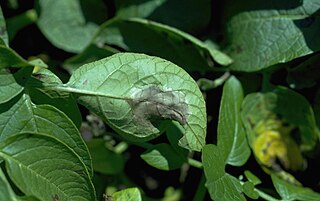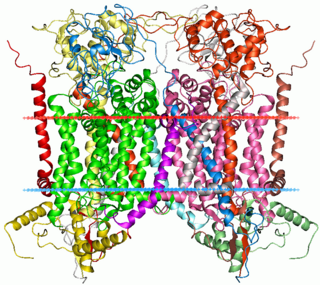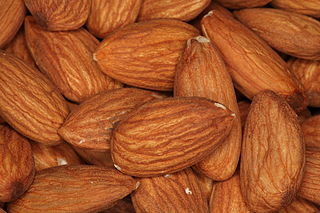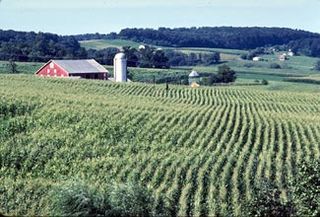
Phytophthora infestans is an oomycete or water mold, a fungus-like microorganism that causes the serious potato and tomato disease known as late blight or potato blight. Early blight, caused by Alternaria solani, is also often called "potato blight". Late blight was a major culprit in the 1840s European, the 1845–1852 Irish, and the 1846 Highland potato famines. The organism can also infect some other members of the Solanaceae. The pathogen is favored by moist, cool environments: sporulation is optimal at 12–18 °C (54–64 °F) in water-saturated or nearly saturated environments, and zoospore production is favored at temperatures below 15 °C (59 °F). Lesion growth rates are typically optimal at a slightly warmer temperature range of 20 to 24 °C.

Botrytis cinerea is a necrotrophic fungus that affects many plant species, although its most notable hosts may be wine grapes. In viticulture, it is commonly known as "botrytis bunch rot"; in horticulture, it is usually called "grey mould" or "gray mold".
Fungicides are pesticides used to kill parasitic fungi or their spores. They are most commonly chemical compounds, but may include biocontrols and fungistatics. Fungi can cause serious damage in agriculture, resulting in critical losses of yield, quality, and profit. Fungicides are used both in agriculture and to fight fungal infections in animals. Fungicides are also used to control oomycetes, which are not taxonomically/genetically fungi, although sharing similar methods of infecting plants. Fungicides can either be contact, translaminar or systemic. Contact fungicides are not taken up into the plant tissue and protect only the plant where the spray is deposited. Translaminar fungicides redistribute the fungicide from the upper, sprayed leaf surface to the lower, unsprayed surface. Systemic fungicides are taken up and redistributed through the xylem vessels. Few fungicides move to all parts of a plant. Some are locally systemic, and some move upward.

Phytoalexins are antimicrobial substances, some of which are antioxidative as well. They are defined, not by their having any particular chemical structure or character, but by the fact that they are defensively synthesized de novo by plants that produce the compounds rapidly at sites of pathogen infection. In general phytoalexins are broad spectrum inhibitors; they are chemically diverse, and different chemical classes of compounds are characteristic of particular plant taxa. Phytoalexins tend to fall into several chemical classes, including terpenoids, glycosteroids, and alkaloids; however the term applies to any phytochemicals that are induced by microbial infection.

Captan is a general use pesticide (GUP) that belongs to the phthalimide class of fungicides. It is a white solid, although commercial samples appear yellow or brownish.

Cytochrome b within both molecular and cell biology, is a protein found in the mitochondria of eukaryotic cells. It functions as part of the electron transport chain and is the main subunit of transmembrane cytochrome bc1 and b6f complexes.

Phthalimide is the organic compound with the formula C6H4(CO)2NH. It is the imide derivative of phthalic anhydride. It is a sublimable white solid that is slightly soluble in water but more so upon addition of base. It is used as a precursor to other organic compounds as a masked source of ammonia.

Dicarboximidefungicides are a family of agricultural fungicides that include vinclozolin, iprodione, and procymidone. Dicarboximides are believed to inhibit triglyceride biosynthesis in sclerotia-forming fungi, including Botrytis cinerea. These fungicides turn into 3,5-dichloroaniline in soil rapidly. Repeated use of dicarboximides over several years reduce their effectiveness. Resistance has developed against all dicarboximides in many plant species, including vines, strawberries and protected crops, and are recommended to be used in conjunction with other fungicides.
Florida was ranked in 2019, "first in the value of production for fresh market bell peppers and tomatoes, as well as grapefruit, oranges, sugarcane, and watermelons" in the United States according to Florida Agriculture by the Numbers. In 2002 peppers and tomatoes were #1 and #2 in dollar value for the state and citrus fruit, especially oranges, were also a major part of the economy. By 2019 tomatoes were #1, oranges #2, and peppers were #3. Of exports, meat is Florida's biggest earner. Florida produces the majority of citrus fruit grown in the United States.

Fludioxonil is a non-systemic fungicide, introduced in 1993 by Ciba-Geigy. It is used for the treatment of crops, particularly cereals, fruits and vegetables, and ornamental plants. It is often used in combination with another fungicide such as Cyprodinil.

Thiophanate-methyl is an organic compound with the formula C6H4(NHC(S)NH(CO)OCH3)2. The compound is a colorless or white solid, although commercial samples are generally tan-colored. It is prepared from o-phenylenediamine. It is a widely used fungicide used on tree, vine, and root crops. In Europe it is applied to tomato, wine grapes, beans, wheat, and aubergine.

Agriculture is a significant sector in California's economy, producing nearly US$50 billion in revenue in 2018. There are more than 400 commodity crops grown across California, including a significant portion of all fruits, vegetables, and nuts in the United States. In 2017, there were 77,100 unique farms and ranches in the state, operating across 25.3 million acres of land. The average farm size was 328 acres (133 ha), significantly less than the average farm size in the U.S. of 444 acres (180 ha).

The US state of Maryland has large areas of fertile agricultural land in its coastal and Piedmont zones, though this land use is being encroached upon by urbanization. Agriculture is oriented to dairy farming for nearby large city milksheads, plus specialty perishable horticulture crops, such as cucumbers, watermelons, sweet corn, tomatoes, muskmelons, squash, and peas.

Botrytis elliptica is a necrotrophic fungal pathogen which infects species of plants in the Lilium genus, causing the disease commonly known as Lily Gray Mold. The symptoms of Lily Gray Mold include the appearance of water-soaked spots on leaves which appear white and increase in darkness with age, ranging from gray to brown. These spots may cover the entire leaf, complemented with a gray webbing, containing the fungal spores. The leaves will appear wilted and branches may die back. In addition to leaves, petals, stems, and buds may be infected, and this gray webbing will eventually cover the plant, feigning the appearance of gray flowers. Infected buds often rot. Lily Gray Mold disease, if not properly treated, will appear each year with increasing vigor.

Pyraclostrobin is a quinone outside inhibitor (QoI)-type fungicide used in agriculture. Among the QoIs, it lies within the strobilurin chemical class.
cv. 'Camino Real' is a cultivar of strawberry produced by the Shaw & Larson era of the UC Davis breeding program.

Boscalid is a broad spectrum fungicide used in agriculture to protect crops from fungal diseases. It was first marketed by BASF in 2002 using their brand name Endura. The compound is an biphenyl amide derived inhibitor of succinate dehydrogenase.

Strawberries in the United States are almost entirely grown in California – 86% of fresh and 98% of frozen in 2017 – with Florida a distant second. Of that 30.0% was from Monterey, 28.6% from Ventura, 20.0% from Santa Barbara, 10.0% from San Luis Obispo, and 9.2% from Santa Cruz. The Watsonville/Salinas strawberry zone in Santa Cruz/Monterey, and the Oxnard zone in Ventura, contribute heavily to those concentrations.

Pydiflumetofen is a broad spectrum fungicide used in agriculture to protect crops from fungal diseases. It was first marketed by Syngenta in 2016 using their brand name Miravis. The compound is an amide which combines a pyrazole acid with a substituted phenethylamine to give an inhibitor of succinate dehydrogenase.



















